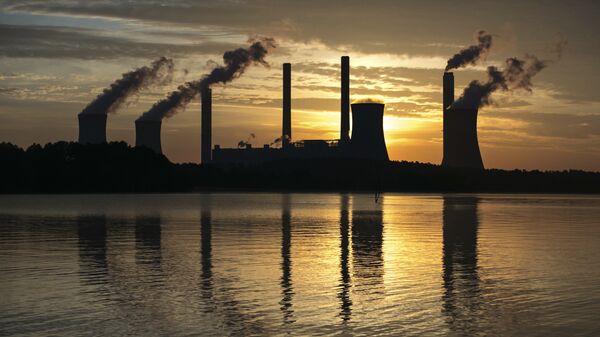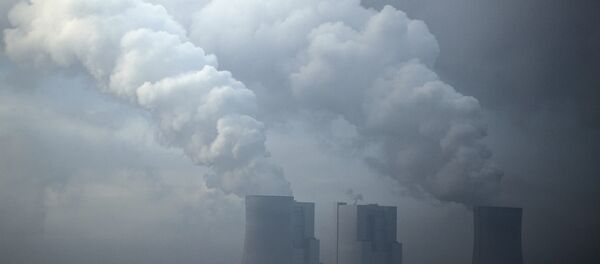The National Development and Reform Commission, China’s top economic planner, announced the plan to launch a nationwide carbon trading program this week, which is expected to cover about 1700 of the country's power-generating companies with an estimated annual emission of 3 billion tonnes of carbon dioxide.
After US President Donald Trump announced his decision to withdraw from the Paris Accord that aims to curb global greenhouse gas emission, Chinese leaders have pledged on various occasions that the nation would continue to work with partners from the rest of the world to push forward the international initiative to combat climate change.
No Structural Change in Energy Mix
"Although the detailed rules on the China’s carbon trading market have not been released to the public, according to submitted proposals, each kind of power generation source, such as coal or natural gas, would have its own emission cap. Under this mechanism, the focus will be on improving efficiency of existing plants, instead of pushing structural reforms that would replace coal with gas or other cleaner energy sources," Zhang Junjie, director of the Environmental Research Center at the Duke Kunshan University in eastern China’s Jiangsu province, told Sputnik.
However, the expert believes the recently announced carbon trading scheme is moving toward the right direction by targeting the power-generating industry.
"The power-generating industry is the largest emitter in China and also the largest consumer of coal, as over 50 percent of China’s coal consumption comes from this industry. And this industry has a good foundation of basic statistics on emission. During the carbon market trials, this industry was also covered. The power generation industry has the best foundation to start carbon trading. As most of the companies in the industry are state-owned companies, it’s easier to implement the carbon trading scheme. It’s a reasonable choice to pick this industry," Zhang said.
The Kunshan-based scholar pointed out that the carbon trading markets in the European Union and some US states such as California have also primarily focused on the power generation industry.
READ MORE: RUMBLE Program: Russia, EU Team Up to Create Supersonic Aviation of the Future
Official figures showed that over 65 percent of all electricity generated in China in 2016 came from coal-fired power plants. Despite rapid growth in power generation from renewable energy such as hydro, wind and solar, their overall contribution to China’s electricity generation stood at 24.4 percent last year, with hydro taking up about 18.9 percent. Contribution from wind and solar combined only accounted for about 5 percent of China’s total electricity generation in 2016.
A More Feasible Solution
As part of Chinese authorities’ efforts in solving the nation’s severe air pollution problem, which has been viewed as a possible threat to the ruling Communist Party’s image, a pilot program was launched in 28 cities earlier this year to covert heating systems powered by coal to natural gas.
READ MORE: Beep Beep! Electric Cars Now Cheaper to Run Than Fossil Fuel Cars — Study
Environmental experts believe the carbon trading scheme is a much better solution to promote the use of cleaner energy such as natural gas, compared to executive orders.
"China’s coal-to-gas conversion campaign primarily serves the purpose of solving the nation’s air pollution problem. This administrative method focuses on executive orders and strict control. This method is very simple and raw, without taking the economic feasibility into consideration. When problems emerged, they had to correct course. But the carbon market is a more advance and more effective method that is based on market demand. The transition from coal to cleaner energy sources come from economic incentives. This market-oriented method comes at a much lower cost, which allows the companies to decide which energy source they prefer," Zhang from Duke Kunshan University said.
Lin Boqiang, director of the China Institute for Studies in Energy Policy at Xiamen University in southeastern China, expressed similar views on the effectiveness of the carbon trading scheme, compared to administrative measures.
"In the short term, administrative measures are a lot more effective than market-oriented incentives, as the results from executive orders often come at once. But such administrative measures would also bring a heavy cost. The carbon trading market can help minimize the cost of emission reduction," Lin told Sputnik.
Coal Vs Gas
Scientists estimate natural gas, despite being a fossil fuel, emits about 50 to 60 less CO2 when combusted in a new, efficient natural gas power plant compared with emissions from a typical new coal plant. The burning of natural gas also produces negligible amounts of sulfur, mercury and particulates that contribute to air pollution, which makes a much cleaner alternative than coal, according to a report from the Union of Concerned Scientists in the United States.
"If natural gas contribution in China’s energy consumption can reach 15 percent, from the current 7 percent, it would make a huge difference. That’s because if China can reduce coal’s contribution to the energy consumption by 8 percent, its greenhouse emission peak would have passed a long time ago. If China can reduce coal’s contribution to about 40 percent and raise the contribution of natural gas to about 20 percent, we will see blue sky everywhere in the country," he said.
According to targets set by Chinese authorities, the nation plans to raise the natural gas contribution to the nation’s energy consumption to 10 percent by 2020 and to 15 percent by 2030. Official figures showed the contribution of natural gas to China’s energy consumption stood at 6.4 percent in 2016.
READ MORE: Collapse in Coal Industry Threatens Europe’s Energy Independence
However, Lin pointed out that China may face a bottleneck in natural gas supply as the nation does not want to rely overly on imports.
"The Chinese government definitely does not want to expand China’s reliance on natural gas imports. That’s because natural gas supply depends on relations between two countries. For example, China is planning to build two gas supply pipelines with Russia. You wouldn’t want to rely too much on one country. Compared to pipeline gas supply, liquefied natural gas (LNG) can only be a supplementary source of supply. It’s impossible for us to rely on LNG as a primary source of supply like developed nations such as Japan. The cost would be too high," he said.
In 2014, Russian oil giant Gazprom signed a 30-year framework agreement with CNPC for annual deliveries of 38 billion cubic meters of Russian gas through the eastern route pipeline, formally known as the Power of Siberia. In 2015, the accord was supplemented by a deal on the construction of the Power of Siberia-2 pipeline, which will have a capacity of 30 billion cubic meters (about 1.06 trillion cubic feet).
The Xiamen-based expert suggested that developing the domestic shell gas industry would be a more reasonable solution for China’s massive demand for natural gas. Lin estimates China’s annual natural gas consumption is expected to triple from the current level of around 200 billion cubic meters (7.06 trillion cubic feet) if the nation is to meet the target of natural gas contributing to 15 percent of overall energy consumption annually.
The new carbon trading scheme has demonstrated China’s commitment to pledges on combating climate change, Zhang from Duke Kunshan University suggested.
"As China made promises to reduce emissions on the global stage, including signing the Paris Accord or even the earlier agreement on greenhouse gas emission reduction between Chinese and US leaders, Beijing pledged to reach its emission peak by 2030. This is a major step for China to keep these promises through a market-oriented mechanism," he said.
However, it is important not to neglect responsibilities developed nations need to take on similar efforts, the Chinese expert argued.
"We need to be careful when it comes to whether China needs to lead the global climate change efforts. When it comes to greenhouse gas emission, it’s about how to distribute the responsibilities internationally. The existing greenhouse gas [in the atmosphere] primarily came from emissions of developed countries after the Industrial Revolution. Developed nations led by the Unites States need to take a larger responsibility on emission reduction. It is not about the United States can relieve its responsibilities and let China take over," Zhang said.
Nevertheless, for China to unveil the carbon trading market this year, it has become a strong boost to the global efforts in combating climate change, amid uncertainties following Trump’s decision to withdraw from the Paris Accord, he added.
READ MORE: Domestic Pollution Problems Force China to Stay Strong on Climate Change
Hope For Renewable Energy
"China made new records with solar power this year and the growth of carbon-free electricity is extremely impressive. I think there’s no doubt about the domestic efforts are. Right now they’re driven by domestic energy policies. The announcement of the carbon market is another sign that China is moving in the right direction," Lauri Myllyvirta, a researcher for Greenpeace in Beijing, told Sputnik.
However, Zhang, the professor at Duke Kunshan University, argued that reducing greenhouse gas emissions is a much lower priority for Chinese government compared with the pressing issue of solving the deadly air pollution problem.
"For Chinese authorities, environmental concern, especially air pollution, is a much strong driver than reducing greenhouse gas emissions. China’s efforts in improving the air quality happened to help reduce greenhouse gas emission," he said.
The scholar believes China needs to resolve the most pressing issue, which is air pollution, first, before thinking more about combating climate change.
READ MORE: UN, World Powers Renew Call for Climate Action at One Planet Summit in Paris








